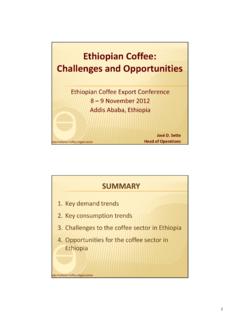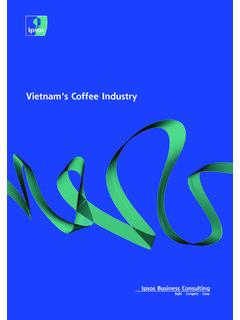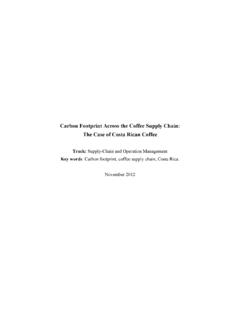Transcription of Coffee and Refractometers - VSTAPPS
1 2010 Voice Systems Technology, Inc. (VST) About Coffee and Refractometers 2008-2010 Voice Systems Technology, Inc. (VST) Coffee and Refractive Index Refractive Index measurements have been used for process control in the food industry since the 1940 s. Typical measurements are usually for sugars in fruits, such as melons, orange and other juices, sugar content in grapes for the wine industry and many other examples. Refractive Index is directly related to the Total Dissolved Solids in solution of Coffee .
2 To the best of our knowledge, no one has ever provided an easy to use, accurate and portable refractive index device calibrated specifically for coffees. Previous methods for TDS measurement of Coffee include the oven drying dehydration method, which is slow and expensive but highly accurate, conductivity instruments which are difficult to calibrate and have proven unreliable and the hydrometer method, which is delicate, temperature sensitive and impractical in most environments. To provide a meaningful solution to this problem, VST has partnered with a world leading manufacturer of optical instruments to develop a state-of-the-art refractometer designed specifically for Coffee , called the VST- Coffee refractometer manufactured by Reichert Analytical Instruments.
3 Reichert is a well known optical instrument manufacturer, and their products have won technical achievement awards for their innovative design, accuracy and practical use in the field for hundreds of applications. Coffee Process Control and the importance of TDS in Quality Internationally accepted quality standards in the specialty Coffee industry established [in the 1950 s] that extraction of approximately 20% by weight of the ground Coffee will achieve the best quality brewed Coffee , using various brew methods. The precise extraction percent may be varied for particular coffees, along with the strength, to achieve finely tuned recipes for particular Coffee cultivars, growing regions, climate, ,terroir, and roast characteristics.
4 Up to 30% of the available soluble solids in [ground] Coffee can be extracted, with most of the remaining 70% being cellulose, and not soluble in water. However, generally speaking, extracting more than 21% will begin to sharply increase those components in Coffee that contribute to bitter taste defects associated with over-extraction. Extracting less than 18% is generally associated with weak, under-developed taste defects. In order to determine the actual level of extraction reached for a particular Coffee batch, one must know the brew formula and the soluble solids in final solution, or Total Dissolved Solids (% TDS).
5 The brew formula is simply the water amount by weight, and the ground Coffee weight used in the batch. 2010 Voice Systems Technology, Inc. (VST) The Brew Formula is expressed as a curve on a brewing control chart, seen as the green line in FIG. 1, below. The TDS is measured using the VST- Coffee refractometer at , and plotted on the Brew Formula line in red. The percent extraction can then be read directly off the chart. In FIG. 1, the extraction in this design example is exactly 20%. Another way of expressing this example is that 20% of 58 grams of Coffee , or about grams of Coffee were extracted and dissolved into approximately 858 grams solution, or about soluble solids in solution.
6 FIG. 1 Refractometers and Temperature The VST Coffee refractometer is temperature corrected. Each unit is tested for accuracy against a known standard and typically reads to an extrapolated accuracy of +/- from 15-30 Deg C (although the warranted accuracy is + ). This is accurate enough for most applications for Coffee in the field. Higher accuracy Refractometers for research and laboratory use are available at 2010 Voice Systems Technology, Inc. (VST) Though temperature corrected, this does not mean that hot Coffee placed on a cooler refractometer prism.
7 Temperature correction means that the Coffee sample and the instrument prism are stable at the same temperature, and in the temperature corrected range of 15 to 30 Deg C. Maintaining Accuracy In order to get the most accurate TDS measurements, one should calibrate the refractometer using deionized or distilled water stored at room temperature, along with the refractometer . Check the refractive index (nD) against a table for DI water at the temperature indicated when using the refractometer in its native mode ( , reading nD and TEMP).
8 Then, cool the Coffee sample to room temperature and transfer into the refractometer sample well, and allow time for the Coffee sample and prism to reach the same temperature. Then take a reading. Therefore, in order to obtain best accuracy, do not take the refractometer out of your warm pocket or out of a cold car (in winter) and immediately expect it to work accurately. Allow time for the refractometer to reach ambient temperature and calibrate before use. Using the VST Coffee refractometer When using the Coffee , and most other Refractometers , the sample MUST be at the same temperature as the PRISM for an accurate measurement.
9 Automatic Temperature Compensation (ATC) compensates for shifts in ambient temperature, not for the difference between Coffee sample and prism temperature. Read the simple calibration and measurement technique sections, below, for an understanding of how to make accurate measurements. Calibrate Using Distilled Water Store the refractometer and a container of distilled water at room temperature, and calibrate if there is a change in ambient temperature of more than a few degrees C. VST recommends calibration and use within a range of 15-30 Deg C, which should easily accommodate most room temperature conditions.
10 Measurement Technique After brewing your Coffee , be certain to stir the final solution before sampling. Then, pour a few grams of Coffee into a clean and DRY glass or porcelain cup, allowing the cups mass to absorb thermal energy, and cool the sample. If necessary, transfer into a second glass, and allow to cool. When cooled to ambient temperature transfer the sample to the refractometer sample well using a pipette, using a few drops to completely cover the glass. Leave the sample on the prism for 15-30 seconds before taking an initial reading.






